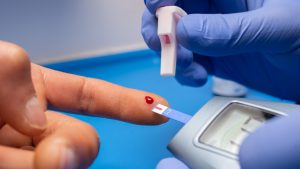Alexandra Park is an accomplished actress, writer, and producer, best known for her role as Princess Eleanor in the TV series The Royals and her work on the Australian series Home and Away. Currently residing in Los Angeles with her husband and beloved dog, Alexandra’s journey took an unexpected turn when she received her diabetes diagnosis just as she was about to embark on a new chapter in her life.
A Timing That Challenged Dreams
Receiving the diagnosis of type 1 diabetes just two months before her move to Los Angeles was overwhelming. Her doctors advised her to cancel the move, but Alexandra’s determination prevailed, and she moved as planned. Shortly after settling in, she landed the role of Princess Eleanor, which took her off to London for filming.
However, the excitement of her new career came with significant challenges. On set, Alexandra was fixated on maintaining her blood sugar levels within range. The mental exhaustion and feelings of isolation that came with managing her diabetes while working in a high-pressure environment were daunting. She established a routine before each scene—checking her blood sugar, keeping glucose handy, and administering insulin when necessary. Although she felt she had things under control, the fear of her condition interfering with her performance or letting the crew down weighed heavily on her.
Struggling with Acceptance
In the midst of her success, Alexandra found herself in denial about her diabetes. She often pushed her condition aside while juggling the demanding schedule of a lead actress in a foreign country. Unfortunately, this denial led to several frightening experiences with hypoglycemia, including one incident where her blood sugar dropped so low that she lost consciousness.
It was this alarming episode that finally prompted her to accept her condition. While being diagnosed with diabetes brought a new set of challenges, Alexandra realized that it didn’t have to derail her goals and aspirations. With proper management, she could still live her life on her terms.
Finding the Right Management
Alexandra’s journey taught her that the most crucial aspect of living with diabetes is finding the management system that works best for each individual. For a long time, she managed her condition using Multiple Daily Injections (MDI), but she later switched to an automated insulin delivery system. This transition significantly improved her ability to balance blood sugar highs and lows, positively impacting her mood, energy levels, and overall health. The technology works diligently in the background, allowing her to focus on what truly matters: her career and personal life.
Overcoming Guilt and Stress
For many living with type 1 diabetes, feelings of guilt or shame can arise from the challenges of managing blood sugar levels. Alexandra acknowledges that it’s stressful to think about the long-term implications of prolonged highs and the cumulative effects on health. The fear of potential complications is real, and she emphasizes the importance of striving for good health for as long as possible.
A Supportive Community
Living with diabetes is undoubtedly challenging, but Alexandra’s story highlights the advancements in technology, the increasing awareness of the condition, and the vital role of a supportive community. These elements have made managing diabetes much more feasible, allowing her to pursue her dreams without being held back by her diagnosis.
A Message of Hope
Alexandra Park’s journey is a testament to resilience and determination. She exemplifies that while diabetes can introduce obstacles, it does not have to hinder our ambitions. By embracing her condition, seeking the right management strategies, and leaning on a supportive network, she has carved out a successful and fulfilling life in the spotlight.
For anyone living with diabetes, let Alexandra’s story inspire you to face your challenges head-on. Remember, managing diabetes is a journey, and with the right tools and support, it’s possible to thrive and pursue your dreams.

Type 2 Diabetes: Is It Really Reversible?
A recent National Geographic article [link] explores how type 2 diabetes could be reversible with the right approaches. This condition, which affects millions of people worldwide, has long been considered a chronic and progressive disease. However, recent research challenges this perception and suggests that with lifestyle changes and the right approach, remission is possible. The

How Do GLP-1 Drugs Compare? A Breakdown of Ozempic, Mounjaro, and Trulicity
GLP-1 receptor agonists have revolutionized diabetes management, with drugs like Ozempic, Mounjaro, and Trulicity leading the market. But how do these medications compare in terms of effectiveness, side effects, and patient outcomes? Let’s explore their differences and what they mean for diabetes patients. Understanding GLP-1 Medications GLP-1 receptor agonists mimic a natural hormone that helps

Why Has Medicare Spending on Diabetes Medications Skyrocketed in 5 Years?
In the past five years, Medicare spending on diabetes medications has increased nearly fivefold, reaching $35.8 billion in 2023. This surge has been primarily driven by the growing use of GLP-1 drugs such as Ozempic, Mounjaro, and Trulicity. But what is behind this cost escalation, and how does it affect patients and the U.S. healthcare

The Gut Microbiota and Blood Sugar Control: A Hidden Connection
The human gut is home to trillions of bacteria that play a crucial role in digestion, immune function, and even metabolism. Recent research has revealed a fascinating link between the gut microbiota and blood sugar regulation, shedding light on how the balance of microbes in our intestines can influence diabetes risk and overall metabolic health.

The Dawn Phenomenon: Why Blood Sugar Rises While You Sleep
For many people with diabetes, waking up with high blood sugar levels can be frustrating—especially if they didn’t eat anything overnight. This early-morning spike in blood glucose is known as the Dawn Phenomenon, and it happens due to natural hormonal changes in the body. But why does it occur, and how can it be managed?

The Influence of Red Light on Blood: Can It Improve Diabetes?
Type 2 diabetes is a metabolic disease characterized by insulin resistance and elevated blood glucose levels. In the search for complementary alternatives to improve glycemic control, red light therapy has gained attention due to its potential to enhance circulation, reduce inflammation, and optimize cellular function. But what does science say about it? ✨ What is

